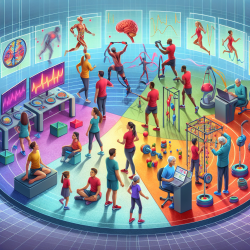Introduction
In the realm of speech-language pathology and therapeutic practices, the integration of data-driven insights is pivotal for enhancing outcomes. A recent study, "Linking Brain Stroke Risk Factors to Human Movement Features for the Development of Preventive Tools," provides a groundbreaking approach that can be harnessed by practitioners to improve their skills and ultimately create better outcomes for children.
The Power of Movement Analysis
The study explores the potential of using human movement analysis to assess brain stroke susceptibility. By analyzing a variety of neuromuscular tests, researchers were able to extract predictive characteristics associated with stroke risk factors such as obesity, diabetes, hypertension, and more. This approach is not only innovative but also promising, with the Area Under the Receiver Operating Characteristic Curve (AUC) values mostly ranging between 0.6 and 0.9, indicating a fair to excellent diagnostic capability.
Implementing Insights into Practice
For practitioners, especially those involved in therapeutic services for children, integrating movement analysis into routine assessments can provide a more comprehensive understanding of a child's neuromuscular health. Here are some actionable steps:
- Adopt Neuromuscular Testing: Incorporate a battery of neuromuscular tests to evaluate movement kinematics and identify potential risk factors early.
- Data-Driven Decision Making: Utilize the statistical insights from movement analysis to tailor intervention plans more effectively.
- Continuous Learning: Stay updated with the latest research and methodologies to refine assessment techniques and improve outcomes.
Encouraging Further Research
While the current findings are promising, further research is needed to refine the methodology and enhance its applicability. Practitioners are encouraged to engage in collaborative research efforts to explore the full potential of movement analysis in preventive healthcare. By doing so, they can contribute to the development of more precise diagnostic tools and preventive strategies.
Conclusion
The integration of movement analysis into therapeutic practices represents a significant advancement in preventive medicine. By leveraging these insights, practitioners can not only improve their skills but also make a profound impact on the lives of children. This approach aligns with TinyEYE's mission to provide exceptional online therapy services that are informed by the latest scientific research.
To read the original research paper, please follow this link: Linking brain stroke risk factors to human movement features for the development of preventive tools.










